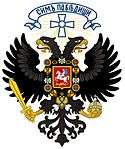Government of South Russia
| Government of South Russia | ||||||||||
| Правительство Юга России Pravitel'stvo Yuga Rossii | ||||||||||
| ||||||||||
| ||||||||||
| Capital | Sevastopol | |||||||||
| Languages | Russian | |||||||||
| Government | Martial law | |||||||||
| Ruler | ||||||||||
| • | 1920 | Pyotr Wrangel | ||||||||
| Historical era | Russian Civil War | |||||||||
| • | Established | April 1920 | ||||||||
| • | Dissolved | 16 November 1920 | ||||||||
| ||||||||||
The Government of South Russia (Russian: Правительство Юга России Pravitel'stvo Yuga Rossii) was a White movement government established in Sevastopol, Crimea in April 1920.
It was the successor to General Anton Denikin's South Russian Government (Южнорусское Правительство Yuzhnorusskoye Pravitel'stvo) set up in February 1920.[1]
General Pyotr Wrangel was the pravitel' (правитель, "ruler")[2] while the head of the government itself was the Chairman of the Council of Ministers, Alexander Krivoshein, with Peter Berngardovich Struve serving as foreign minister. The government officially adopted the name "Government of South Russia" on 16 August 1920, and it controlled the area of the former Russian Empire's Taurida Governorate, i.e., the Crimean Peninsula and adjacent areas of the mainland.
The Government of South Russia received assistance from the World War I Allies including France (which recognized it in August 1920) and the United States, as well as from the newly independent Poland. However, foreign support gradually dried up so offensives of the former Armed Forces of South Russia and the Volunteer Army, now called the Russian Army, had failed outside of Taurida.
In early November, the Bolsheviks won decisive victories and entered Crimea proper. Wrangel initiated an evacuation of 146,000 people to Constantinople with the last boats departed on 16 November. With this withdrawal, the final remnants of the White forces in Europe were defeated.
References
- ↑ Evan Mawdsley. The Russian Civil War. Pegasus Books, 2007. p. 211. ISBN 978-1-933648-15-6
- ↑ Evan Mawdsley. The Russian Civil War. Pegasus Books, 2007. p. 263. ISBN 978-1-933648-15-6
External links
- 1920-08-11 - Chronicling America - De-facto recognition of the Government of South Russia at the Library of Congress.
- 1920-08-11 - Photo of the Government of South Russia at the encri.ru historical wiki.
- Search Russia Government at russia.search-government.com.

